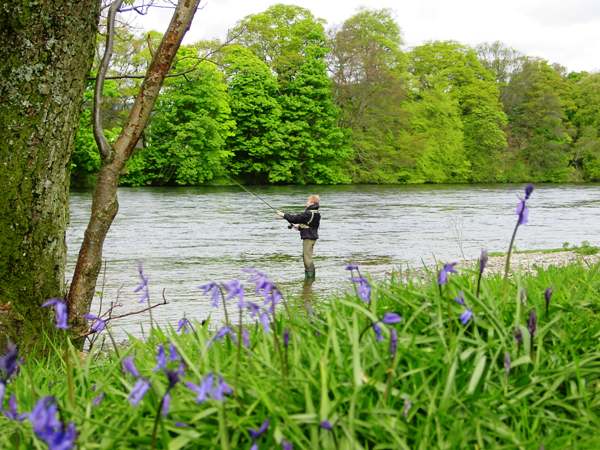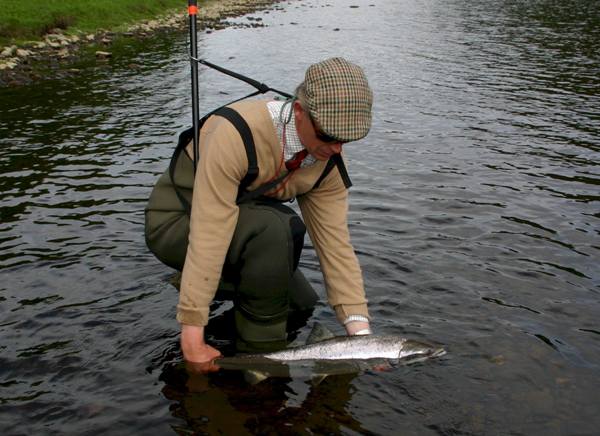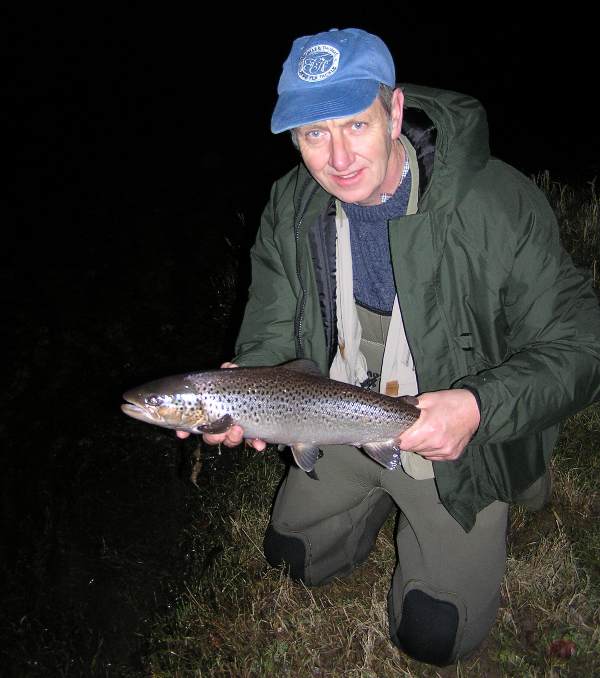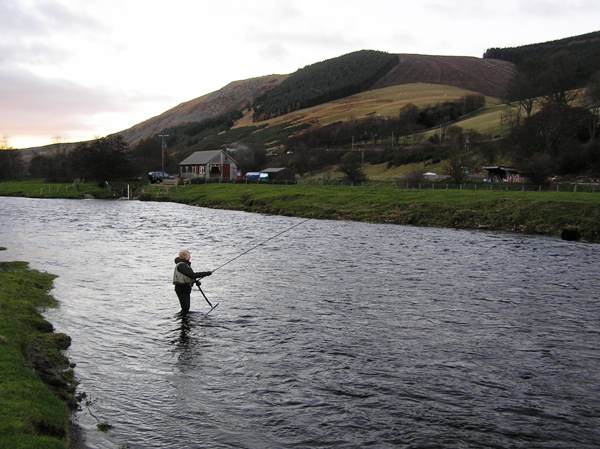Trees Birds Mammals Fish Amphibians Reptiles
Wild Algarve
Bookshop
Flyfishing on Rivers in Scotland
With literally hundreds of lakes, rivers and streams that contain stocks of wild brown trout, sea trout, grayling and salmon, Scotland is a great place for flyfishing. Here are details of some of the rivers that we have fished; we might add a few more when time permits.
River Tay
In terms of average daily flow, the Tay is the biggest river in Britain, although it is by no means the longest. Two of its main branches, the Dochart and the Tummel, rise just a few miles from Loch Fyne and Loch Etive on Scotland's west coast and from there flow more than 100 miles to the North Sea at Perth on the east coast of Scotland.

Sue Parker fishing the Tay at Murthly
The Tay is the famed home of Miss Georgina Ballantine's 64lb monster fish. Caught on the Glendelvine beat in 1922, this superb specimen remains to this day the British record rod-caught salmon. The extensive Tay river system includes many fine tributaries including the rivers Earn, Isla, Ericht, Tummel, Garry, Dochart, Lyon and Eden.
The Tay fisheries are managed by the Tay District Salmon Fisheries Board, a statutory authority whose members include fishery owners, anglers and ghillies representatives. Voluntary bodies contributing to the improvement and conservation of the Tay river system include The Tay Foundation, the Tay Ghillies Association and the River Earn Improvement Association
Salmon fishing
This is without doubt one of the most beautiful of Scottish rivers, and in springtime the Tay Valley is idyllic, with wildflowers adorning its banks and magnificent trees and high hills providing a picture-postcard backdrop. Although in recent years this great river has seen a significant decline in its salmon runs, much is being done to try to reverse this trend, and some notable catches are now being reported, particularly of large spring fish - good news indeed since salmon are generally scarce throughout UK waters.

Michael Evans returning a Tay springer
Do not expect to catch a lot of salmon at that time of year, because the spring run is quite sparse. Also, do note that for stock conservation reasons there are strict controls on the killing of salmon - in particular you are required without delay to return to the river the first fish that you catch. Other restrictions apply at various times of the year and on various beats, so as always the golden rule must be: check the rules before fishing.
Tackle for salmon fishing
A double-handed rod of at least 13 ft and preferably 15 ft is needed to cover the water effectively on this big river, and a sink-tip and a fast-sinking line are essential except in very low-water conditions.
Brown trout and grayling fishing
There are plenty wild brown trout and in many parts of the river some good grayling too; however, in certain areas there are also stocked brown trout as well as the occasional escapee rainbow from trout farms in the river catchment. Most of the mature trout are between 3/4 lb and 1 lb, but fish up to 5 lbs are occasionally reported.
There are numerous angling clubs and associations on the Tay system that offer fishing for brown trout and grayling; most can offer offer daily, weekly and season tickets, with discounts for senior citizens and youngsters.
River Tweed
Tweed, the second longest river in Scotland, rises at Wells of Tweed, some 1500 feet up in the hills north of Moffat. From there it flows eastwards for 98 miles entering the North Sea at Berwick. For the last 19 miles of its course the river flows through England.

Pat O'Reilly with a nice sea trout from the Upper Caberston fishery at Walkerburn
Although most famous as an autumn salmon river (Tweed has produced well over 10,000 salmon per year in recent seasons) the river also holds good numbers of sea trout as well as brown trout and grayling.
Tweed tributaries
On its way to the sea the River Tweed receives waters from several major tributaries, most notably the Yarrow and Ettrick, Gala Water, Leader Water, Teviot, Till and Whiteadder.
The Tweed river system is governed by the River Tweed Commissioners (RTC) who were set up by the Tweed Fisheries Act in 1857. The Commissioners comprise representatives from both the public and private sectors, including landowners, angling clubs and commercial fisheries. The Tweed Foundation, a charitable trust, was formed in 1983 to enhance and maintain all species of fish in the Tweed catchment. Many other Rivers Trusts and Foundations across the UK have since copied this successful model.
Salmon fishing
At the time of writing, Tweed opens for salmon fishing on 1st February and closes at midnight on 30th November. While noted for its autumn run of large salmon, Tweed also has a fairly good run of spring fish and a grilse run in late summer.
In all but low water conditions a double-handed rod of 13 or 15 ft is needed to cover the water effectively. In summer it is sometimes possible to fish with just a floating line, but for most of the year you are advised to bring also sink tips and a fast sinking line with flies sized to suit the conditions. Ally's Shrimp and Cascade are of course popular on Tweed as elsewhere, but your own favourite salmon fly patterns will do the business provided you get them down to where the salmon are.

Sue Parker fishing for salmon on Tweed
Trout Fishing
In addition to the world-class salmon fishing on Tweed, there is some excellent trout fishing; most of this is administered by angling clubs who sell permits at very reasonable prices. Note that trout fishers are required to give way to salmon fishers in the event of potential conflict, and in practice there is generally a very good relationship between trout and salmon fishers on this great river.
Tweed trout fishing is highly regarded in Scotland but perhaps not as well known outside the country as it's quality would justify. We have enjoyed some wonderful spring and autumn fishing for wild trout that average not far short of the 3/4 lb mark, with plenty of larger fish. It is a river with reasonably good hatches of upwinged flies and sedges - in fact the densest Grannom hatch we have ever seen was on the upper reaches of Tweed, and the trout gorged themselves. (Pat O'Reilly's bestselling illustrated book Matching the Hatch covers all of these aspects.) The best fishing then is during the early stages of the hatch, when there is a chance that your fly will be seen among the hundreds of naturals that soon become thousands!
A 9 or 9.5 ft rod rated at #5 or #6 is ideal, since at times you will need to make quite long casts to cover rishing fish. General imitation dry flies are usually good enough unless the trout are locked on to abundant BWO spinners or to large sedges. When nothing is rising, heavily-weighted nymphs are effective for trout and grayling, and sizes 16 and 18 are a good match for most natural ephemeroptera nymphs.
Top of page...
Excited at the prospect of flyfishing? So are we, and we're pretty sure you would find the Winding River Mystery trilogy of action-packed thrillers gripping reading too. Dead Drift, Dead Cert, and Dead End are Pat O'Reilly's latest river-and-flyfishing based novels, and now they are available in ebook format. Full details on our website here...
Buy each volume in ebook format for only £2.47 on Amazon... Paperbacks also available on Amazon at £6.95 each. All proceeds go towards keeping the First Nature website online.
Please Help Us: If you have found this information interesting and useful, please consider helping to keep First Nature online by making a small donation towards the web hosting and internet costs.
Any donations over and above the essential running costs will help support the conservation work of Plantlife, the Rivers Trust and charitable botanic gardens - as do author royalties and publisher proceeds from books by Pat and Sue.